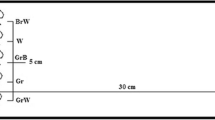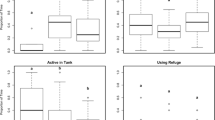Abstract
Chemical cues released from dead or injured organisms constitute important signals informing nearby animals about a feeding possibility. The ability to detect the signal, evaluate its meaning and locate its source can help organisms to exploit food resources efficiently, which is especially important to animals living in environments with limited food supply. Experiments were carried out to study the behavioral responses of several Antarctic benthic invertebrates to fish (Notothenia corriceps) blood. Necrophagous species such as sea stars Odontaster validus and Lysasterias sp., amphipod Waldeckia obesa and nemertean Parborlasia corrugatus responded to fish blood with changes in their behavior. The behavior common to all these species was locomotion directed towards the stimulus source. Behavioral components consistent with food consumption were observed in O. validus and P. corrugatus. The reaction of herbivorous limpets Nacella concinna to fish blood depended on the animal size. Large (>10 mm) limpets showed no behavioral response, whereas small ones (<10 mm) reacted to the stimulus by moving a short distance away. These results indicate that blood released from the tissues of injured or dead animals may be an important chemical signal for organisms belonging to different taxa.

Similar content being viewed by others
References
Arnaud PM (1970) Frequency and ecological significance of necrophagy among the benthic species of Antarctic coastal waters. In: Holdgate MW (ed) Antarctic ecology, vol 1. Academic, London, pp 259–267
Berne S, Sepčić K, Križaj I, Kem W, McClintock JB, Turk T (2003) Isolation and characterisation of a cytolytic protein from mucus of the Antarctic heteronemertine Parborlasia corrugatus. Toxicon 41:483–491
Buchmann K, Nielsen ME (1999) Chemoattraction of Ichthyophthirius multifiliis (Ciliophora) theronts to host molecules. Int J Parasitol 29:1415–1423
Campbell AC, Coppard S, D’Abreo C, Tudor-Thomas R (2001) Escape and aggregation responses of three echinoderms to conspecific stimuli. Biol Bull 201:175–185
Carr WES (1988) The molecular nature of chemical stimuli in the aquatic environment. In: Atema J, Fay RR, Popper AN, Tavolga WN (eds) Sensory biology of aquatic animals. Springer, New York, pp 3–27
Carr WES, Hall ER, Gurin S (1974) Chemoreception and the role of proteins: a comparative study. Comp Biochem Physiol A 47:559–566
Chiszar D, Dunn TM, Stark P, Smith HM (2001) Response of brown treesnakes (Boiga irregularis) to mammalian blood: whole blood, serum, and cellular residue. J Chem Ecol 27:979–984
Clarke A (1983) Life in cold water: the physiological ecology of polar marine ectotherms. Oceanogr Mar Biol A Rev 21:341–353
Clarke A (1988) Seasonality in the Antarctic marine environment. Comp Biochem Physiol B 90:461–473
Clarke A, Leakey RJG (1996) The seasonal cycle of phytoplanton, macronutrients and the microbial community in a nearshore Antarctic marine ecosystem. Limnol Oceanogr 41:1281–1294
Davenport J (1997) Comparisons of the biology of the intertidal subantarctic limpets Nacella concinna and Kerguelenella lateralis. J Molluscan Stud 63:39–48
Dayton PK, Robilliard GA, Paine RT, Dayton LB (1974) Biological accomodation in the benthic community at McMurdo Sound, Antarctica. Ecol Monogr 44:105–128
Dearborn JH (1977) Food and feeding characteristics of Antarctic asteroids and ophiuroids. In: Llano GA (ed) Adaptation within Antarctic ecosystems. Gulf Publishing, Houston, pp 293–326
Dudgeon D, Cheung PS (1990) Selection of gastropod prey by a freshwater crab. J Zool (Lond) 220:147–155
Graeve M, Dauby P, Scailteur Y (2001) Combined lipid, fatty acid and digestive tract content analyses: a penetrating approach to estimate feeding modes of Antarctic amphipods. Polar Biol 24:853–862
Grémillet D, Enstipp RE, Boudiffa M, Liu H (2006) Do cormorants injure fish without eating them? A underwater video study. Mar Biol 148:1081–1087
Gurin S, Carr WE (1971) Chemoreception in Nassarius obsoletus: the role of specific stimulatory proteins. Science 174:293–295
Hammack L, Pomonis JG, Flath RA, Hakk H (1989) Multicomponent attractant for female screwworm flies, Cochliomyia hominivorax, in bovine blood. J Chem Ecol 15:25–36
Hartman BH, Hartman MS (1977) The stimulation of filter feeding in the porcelain crab Petrolithes cinctipes Randall by amino acids and sugars. Comp Biochem Physiol A 56:19–22
Heine JN, McClintock JB, Slattery M, Weston J (1991) Energetic composition, biomass and chemical defense in the common Antarctic nemertean Parborlasia corrugatus McIntosh. J Exp Mar Biol Ecol 153:15–25
Himmelman JH (1988) Movement of whelks (Buccinum undatum) towards a baited trap. Mar Biol 97: 521–531
Janecki T (1999) Reaction of Antarctic sea urchins, Sterechinus neumayeri (Echinodermata: Echinoidea) to glutamic acid and glucose. Pol Arch Hydrobiol 46:325–330
Janecki T, Rakusa-Suszczewski S (2005) The influence of starvation and amino acids on metabolism of the Antarctic amphipod Waldeckia obesa. J Crust Biol 25:196–202
Jørgensen LL (2005) Impact scenario for an introduced decapod on Arctic epibenthic communities. Biol Invasions 7:949–957
Kidawa A (2001) Antarctic starfish, Odontaster validus, distinguish between fed and starved conspecifics. Polar Biol 24:408–410
Kidawa A (2005a) The role of amino acids in phagostimulation in the shallow-water omnivorous Antarctic sea star Odontaster validus. Polar Biol 28:147–155
Kidawa A (2005b) Behavioural and metabolic responses of the Antarctic sea star Odontaster validus to food stimuli of different concentration. Polar Biol 28:449–455
La Mesa M, Eastman JT, Vacchi M (2004) The role of notothenid fish in the food web of the Ross Sea shelf waters: a review. Polar Biol 27:321–338
Lapointe V, Sainte-Marie B (1992) Currents, predators and the aggregations of the gastropod Buccinum undatum around bait. Mar Ecol Prog Ser 85:245–257
Mackay-Sim A, Laing D (1981) Rats’ responses to blood and body odors of stressed and nonstressed conspecifics. Physiol Behav 27:503–510
McClintock JB (1994) The trophic biology of antarctic echinoderms. Mar Ecol Prog Ser 111:191–202
McClintock JB, Klinger TS, Lawrence JM (1984) Chemoreception in Luidia clathrata (Echinodermata: Asteroida): qualitative and quantitative aspects of chemotactic responses to low molecular weight compounds. Mar Biol 84:47–52
McClintock JB, Pearse JS, Bosch I (1988) Population structure and energetics of the shallow-water antarctic sea star Odontaster validus in contrasting habitats. Mar Biol 99:235–246
McDermott JJ, Roe P (1985) Food, feeding behaviour and feeding ecology of nemerteans. Am Zool 25:113–125
McKillup SC, McKillup RV (1992) Inhibition of feeding in response to crushed conspecifics by the pebble crab Philyra laevis (Bell). J Exp Mar Biol Ecol 161:33–43
Morton B, Chan K (1999) Hunger rapidly overrides the risk of predation in the subtidal scavenger Nassarius siquijorensis (Gastropoda: Nassariidae): an energy budget and a comparison with the intertidal Nassarius festvus in Hong Kong. J Exp Mar Biol Ecol 240:213–228
Penney RI, Lowry G (1967) Leopard seal predation on Adelié penguins. Ecology 48:878–882
Petersen CH, Skilleter GA (1994) Control of foraging behavior of individuals within an ecosystem context: the clam Macoma balthica, flow environment, and siphon-cropping fishes. Oecologia 100:256–267
Picken GB (1980) The distribution, growth and reproduction of the Antarctic limpet Nacella (Patinigera) concinna (Strebel 1908). J Exp Mar Biol Ecol 42:71–85
Presler P (1986) Necrophagous invertebrates of the Admiralty Bay of King George Island (South Shetland Islands, Antarctica). Pol Polar Res 7:25–61
Rebach S, French DP, von Staden FC, Wilber MB, Byrd VE (1990) Antennular sensitivity of the rock crab Cancer irroratus to food substances. J Crust Biol 10:213–217
Rittschof D, Shepherd R, Williams LG (1984) Concentration and preliminary characterization of a chemical attractant of the oyster drill, Urosalpinx cinerea. J Chem Ecol 10:63–79
Rittschof D, Tsai DW, Massey PG, Blanco L, Kueber GL Jr, Haas RJ (1992) Chemical mediation of behavior in hermit crabs: alarm and aggregation cues. J Chem Ecol 18:959–984
Rittschof D, Sarrica J, Rubenstein D (1995) Shell dynamics and microhabitat selecyion by striped legged crabs, Clibanarius vittatus (Bosc). J Exp Mar Biol Ecol 192:157–172
Saine-Marie B, Hargrave BT (1987) Estimation of scavenger abundance and distance of attraction to bait. Mar Biol 94:431–443
Shumway SE, Lesser MP, Crisp DJ (1993) Specific dynamic action in the herbivorous marine periwinkles, Littorina Littorea L and Littorina obtusata L (Mollusca, Gastropoda). Comp Biochem Physiol 106A:391–395
Slattery PN, Oliver JS (1986) Scavenging and other feeding habits of lysianassid amphipods (Orchomene spp.) from McMurdo Sound, Antarctica. Polar Biol 6:171–177
Smee DL, Weissburg MJ (2006) Hard clams (Mercenaria mercenaria) evaluate predation risk using chemical signals from predators and injured conspecifics. J Chem Ecol 32:605–619
Smith KL Jr, Baldwin RJ (1982) Scavenging deep-sea amphipods: effects of food odor on oxygen consumption and proposed metabolic strategy. Mar Biol 68:287–298
Sparrevik E, Leonardsson K (1995) Effects of large Saduria entomon (Isopoda) on spatial distribution of their small S entomon and Monoporeia affinis (Amphipoda) prey. Oecologia 101:177–184
Terlouw EMC, Boissy A, Blinet P (1998) Behavioural responses of cattle to the odours of blood and urine from conspecifics and to the odour of faeces from carnivores. App Anim Behav Sci 57:9–21
Thacker RW (1994) Volatile shell-investigation cues of land hermit crabs: effect of shell fit, detection of cues from other hermit crab species, and cue isolation. J Chem Ecol 20:1457–1482
Tiwari F, Singh DK (2004) Behavioural responses of the snail Lymnaea acuminata to carbohydrates in snail-attractant pellets. Naturwissenschaften 91:378–380
Vadas RL, Burrows MT, Hughes RN (1994) Foraging strategies of dogwhelks, Nucella lapillus (L): interacting effects of age, diet and chemical cues to the threat of predators. Oecologia 100:439–450
Wahle RA (1992) Body-size dependent anti-predator mechanisms of the American lobster. Oikos 65:52–60
Wasserman SL, Itagaki H (2003) The olfactory responses of the antenna and maxillary palp of the fleshfly, Neobrllieria bullata (Diptera: Sarcophagidae), and their sensitivity to blockage of nitric synthase. J Insect Physiol 49:271–280
Weissburg MJ, Zimmer-Faust RK (1991) Ontogeny versus phylogeny in determining patterns of chemoreception: initial studies with fiddler crabs. Biol Bull 181:205–215
Wisenden BD, Millard MC (2001) Aquatic flatworms use chemical cues from injured conspecifics to assess predation risk and to associate risk with novel cues. Anim Behav 62:761–766
Zajac RN (1995) Sublethal predation on Polydora cornuta (Polychaeta: Spinidea): patterns of tissue loss in a field population, predator functional response and potential demographic impacts. Mar Biol 123:531–541
Zamorano JH, Duarte WE, Moreno CA (1986) Predation upon Laternula elliptica (Bivalvia, Anatinidae): a field manipulation in South Bay, Antarctica. Polar Biol 6:139–143
Zimmer RK, Butman CA (2000) Chemical signaling processes in the marine environment. Biol Bull 198:167–187
Zimmer-Faust RK, Case JF (1983) A proposed dual role of odor in foraging by the California spiny lobster, Panulirus interruptus (Randall). Biol Bull 164:341–353
Acknowledgments
Data presented in this study were collected during the XXIX Polish Antarctic Expedition at H. Arctowski Station (King George Island, South Shetlands). The work was financed by the State Committee for Scientific Research grant 3 P04F 023 25 (years 2003–2006). Particular thanks are addressed to three anonymous referees for their most helpful comments on the manuscript.
Author information
Authors and Affiliations
Corresponding author
Rights and permissions
About this article
Cite this article
Kidawa, A., Stepanowska, K., Markowska, M. et al. Fish blood as a chemical signal for Antarctic marine invertebrates. Polar Biol 31, 519–525 (2008). https://doi.org/10.1007/s00300-007-0383-y
Received:
Revised:
Accepted:
Published:
Issue Date:
DOI: https://doi.org/10.1007/s00300-007-0383-y




